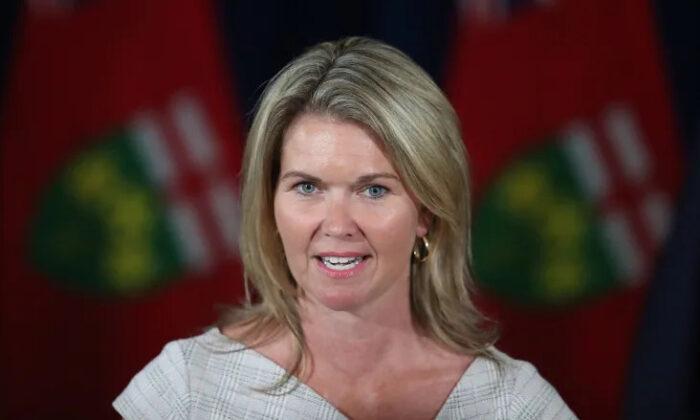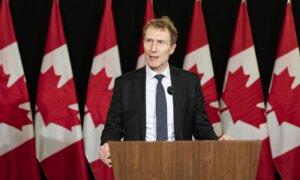Ontario has earmarked nearly $1.3 billion in funding for post-secondary institutions struggling with frozen tuition fees in the face of an upcoming federal cap on international students.
The funding, which will be handed out over a three-year period, is less than half of the recommendation Minister of Colleges and Universities Jill Dunlop received from an expert panel she tapped to examine post-secondary finances.
The lion’s share of the money—$903 million—will go toward a new Postsecondary Education Sustainability Fund, and includes $203 million for schools with “greater” financial needs, Ms. Dunlop announced during a press conference at Queen’s Park on Feb. 26.
Another $167.4 million has been allocated over three years for capital repairs and equipment and $65.4 million will be used to support research and innovation, Ms. Dunlop said. Designated for STEM program costs, $100 million will be handed out to colleges and universities with enrolments above currently funded levels this year.
She also revealed the current tuition fee freeze will continue until at least 2026–2027 in a bid to “reassure” in-province students “who are already struggling with inflation and rising costs.” The province will, however, permit colleges and universities to raise tuition by 5 percent for students from other provinces.
“This is a broad range of measures that will offer much needed stability to the postsecondary sector and help keep costs down for students and their families,” Ms. Dunlop said. “Ultimately, our goal is to put students and their needs first.”
Funding ‘Falls Short’
Council of Ontario Universities president Steve Orsini said while the new funding helps, it’s not enough to sustain the post-secondary sector after an eight-year long tuition freeze.“Today’s announcement, while providing short-term relief, falls far short of what the government’s own expert panel found was urgently required,” Mr. Orsini stated in a press release on Feb. 26. “The Blue-Ribbon Panel’s recommendations were clear: full implementation is critical for the sector’s survival, which would inject about $2.5 billion in ongoing base funding into colleges and universities over the next three years, with $1.9 billion in base funding specifically for universities.”
Ms. Dunlop said the nearly $1.3 billion in funding is the province’s response to the recommendations, and will include $15 million for third-party reviews to identify “structural issues” and find “long-term cost savings.”
“This is a shared responsibility,” she said.
President and CEO of Colleges Ontario Marketa Evans called the funding “a welcome first step,” but said the province’s colleges “expect further action” from the Ontario government.
“The future of the high-quality programs offered to students remains at risk,” Ms. Evan said in a statement.
Mr. Orsini echoed that sentiment, saying multi-year base funding is essential to meet the rising demand for a university education. Applications have grown by more than 11 percent since 2020 and that trend is expected to continue in the future.
Without adequate funding, he said, Ontario high school students will face “greater barriers” in enrolling in their chosen program.
He said universities in the province receive the lowest per-student funding in the country, receiving only 57 percent of the national average. At least 10 institutions are projecting operating deficits of more than $175 million this year as a result, he said. That number will grow to more than $273 million next year.
Foreign Student Cap Effect
Ms. Dunlop laid much of the financial blame at the federal government’s door during her press conference. She called Ottawa’s decision to slash the number of visas for international undergraduate students a “disruption” in the post-secondary sector and pointed out that Ontario will see its allotment cut in half.New visas for international students will be slashed by more than one-third this year to ease the pressure on Canada’s housing system.
Immigration Minister Marc Miller said the cap on new student visas will be implemented for this year and next. The number of new visas handed out this year will be capped at 364,000, a 35 percent decrease from the nearly 560,000 issued last year. The number for 2025 will be set after an assessment of the situation later this year, he said.
International students give more money to Ontario’s institutions than the government does, a report by Higher Education Strategy Associates found. The report ranked Ontario 10th out of 10 in every comparison of interprovincial post-secondary financing.
Raising per-student spending in Ontario to the level of the other nine provinces would necessitate $7.1 billion in annual additional funding—much higher than the current $5 billion, author Alex Usher said.
“Altogether, between inflation and the loss of international students, the sector was in for a hit” of more than $2 billion this year,” Mr. Usher said in response to the announcement.
“This package maybe covers 20 percent of that. It is not a serious attempt to put Ontario’s colleges and universities on solid footing. It is, rather, the act of a government that prefers the appearance of solving problems to actually solving them.”







